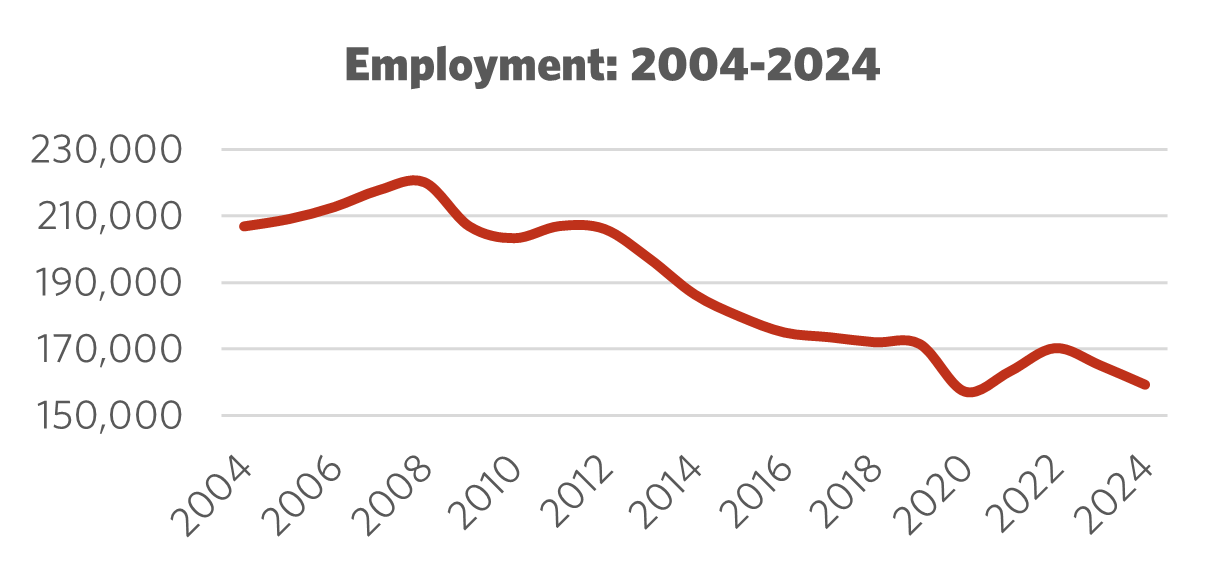Sector Facts and Figures
| Sector Facts and Figures | |
| OUTPUT | |
Sector GDP Share of Canadian GDP | $26.2 billion 1.3% |
| TRADE | |
| Exports | $1.4 billion |
| Imports | $3.4 billion |
| Foreign Trade Balance | -$2.0 billion |
| EMPLOYMENT | |
Total Employment 10-year change | 159,350 -14.5% |
| Percentage of part-time workers | 18.3% |
| Average hourly wage | $49.40/hr |
10-year real wage change | +11.8% |
| Average Work Hours/Week | 32.2 |
| ENVIRONMENT | |
Greenhouse Gas Emissions (2022) 10-year change Share of Canadian industry total | 739kt +12.8% 0.12% |
| LABOUR | |
| Union Coverage Rate | 18.7% |
| Unifor Members in the Industry | 9,000 |
| Share of Total Unifor Membership | 2.8%
|
| Number of Unifor Bargaining Units | 145 |
Unifor in the Media Industry
Unifor members work in a wide array of occupations, including roles in broadcasting (television and radio), film and television production, newspapers, magazines, periodicals, print (including graphic design, pre-press and production) as well as online services.
Approximately 3% of Unifor's membership work in the media sector. Unifor’s 9,000 media members are distributed across 145 bargaining units in nine Canadian provinces, though nearly 60% work in Ontario. This sector of the Canadian economy has above-average levels of union representation, with close to 1 in 5 workers covered by a collective agreement compared to a private sector average of 1 in 6.
Approximately 23% of Unifor media members are employed by Bell Media, which is the largest Unifor employer in this sector. Together with the members at NABET (Local 700-A), Corus, Rogers, the Winnipeg Free Press, and Torstar, the six largest employers in Unifor’s media sector account for more than 58% of the sector’s membership.
| Select Unifor Employers | Approx. # Members |
| Bell Media | 2,100 |
| NABET 700-M | 1,100 |
| Corus | 650 |
| Rogers | 600 |
| Winnipeg Free Press | 375 |
| Torstar | 350 |
Current Conditions
The newspaper and broadcast TV and radio segments of Canada’s media sector continue to face significant challenges. For both print journalism and broadcast media, the funding and financial models that supported the sector for decades have broken down. The rise of digital media – including online news, video streaming, and social media platforms – has completely altered the media landscape, and advertising revenue that supported traditional media is drying up. Revenues for newspaper publishing decreased by almost 50% between 2016 and 2022. For commercial radio, revenues decreased by 24% between 2019 and 2023. In the conventional TV broadcasting segment, revenues decreased by more than 7% between 2022 and 2023 alone.
This period of painful disruption has been a rollercoaster ride in terms of employment levels in the sector. The overall sector employed 159,350 people in 2024, a 14.5% decrease since 2014. However, sector-wide figures fail to tell the whole story, and some segments have seen disastrous job losses in the last decade. For example, since 2014, employment in radio and television broadcasting stations has decreased by almost 30%.
These employment declines reflect a more troubling threat for Canada: the loss of professional news production, including local news, and the telling of Canadian stories. High quality, professional journalism – and especially local news – plays a critical role within a healthy democracy, and Unifor has been advocating for new funding streams to create long-term sustainability for Canadian news businesses.

Figure 1: Employment 2004 – 2024

Figure 2: Nominal vs. Real Wages (2014 = 100)
Moving Forward: Developing the Media Industry
The Canadian Radio-television and Telecommunications Commission (CRTC) is attempting to modernize broadcast policy, driven by the passage of the Online Streaming Act. The legislation requires foreign digital streamers to meaningfully contribute to creating Canadian content. Unifor continues to advocate for a funding model that supports Canada’s news media, specifically local news.
Misinformation and disinformation in the media is an increasing problem, with right-wing populism and authoritarianism surging around the world. Journalists and media workers, their unions, academia, governments and the public all have a role to play in fighting back and promoting the value of reliable, accurate, fact-based news.
Artificial intelligence is now widespread in the overall media sector, and its rate of adoption is accelerating every day. While the use of AI as a tool can improve productivity, it is critical that AI usage is transparent, responsible, and beneficial to media workers and the public. AI must not replace human workers in the sector, and must not undermine public trust in the quality and accuracy of news and media content.
The last few years have seen a drastic and troubling increase in the harassment and abuse of journalists and media workers, and much of this abuse is sexist, racist and Islamophobic in nature. Recognizing there is no single solution to this growing problem, Unifor will work through a variety of means to prevent this abuse and support victims.
Within the film production segment, too many workers experience precarity and job instability due to their status as freelancers and independent contractors. Threats by the Trump Administration to impose tariffs or otherwise deter producers from filming outside the United States is a direct attack on Canada’s film industry. Unifor must continue to fight for collective agreement language, as well as employment and labour law reforms, that will provide increased job security and financial stability for film workers facing these challenges.
Sector Development Recommendations
- The federal government must finalize regulations connected to the Online Streaming Act, which requires foreign digital streaming companies to contribute to the domestic media ecosystem, which a special focus on supporting “boots on the ground” local news.
- Recognizing the rising threat of misinformation and disinformation, industry stakeholders and the broader public must support measures and campaigns that promote the value of fact-based, accurate and transparent news.
- There is no single solution to the growing problem of the harassment and abuse of journalists and media workers, and it will necessary to work through a variety of means to prevent this abuse and support victims.
- There must be broad-based support for policies as well as employment and labour law changes that provide increased job security and financial stability for freelance workers and independent contractors in the film production segment.
- Unions will have to continue to engage with employers, industry experts, academia, and governments to ensure that the use of artificial intelligence in the media sector is transparent, responsible, and beneficial to media workers and the public.


